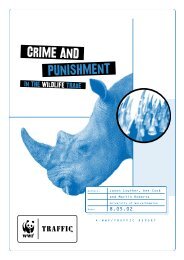In full swing: assessment of trade in orang-utans and ... - WWF UK
In full swing: assessment of trade in orang-utans and ... - WWF UK
In full swing: assessment of trade in orang-utans and ... - WWF UK
Create successful ePaper yourself
Turn your PDF publications into a flip-book with our unique Google optimized e-Paper software.
The bird markets on Java <strong>and</strong> Bali can be considered to consist <strong>of</strong> a (loose) network, with<strong>in</strong> which animals are be<strong>in</strong>g<br />
transported from large markets to smaller outlets, <strong>and</strong> from one side <strong>of</strong> the isl<strong>and</strong> to the other. A few <strong>of</strong> the <strong>trade</strong>rs at<br />
the larger markets, most notably Pramuka bird market <strong>in</strong> Jakarta <strong>and</strong> the Kupang bird market <strong>in</strong> Surabaya, seem to hold<br />
key positions <strong>in</strong> the network. Both actors <strong>in</strong> the <strong>trade</strong>, as well as <strong>in</strong>dividuals monitor<strong>in</strong>g the <strong>trade</strong>, reported these two<br />
markets were key nodes <strong>in</strong> Java’s primate <strong>trade</strong>. Many <strong>trade</strong>rs that did not have gibbons <strong>and</strong> <strong>orang</strong>-<strong>utans</strong> on <strong>of</strong>fer at the<br />
time <strong>of</strong> research <strong>in</strong>dicated that it would be possible to obta<strong>in</strong> one, possibly with<strong>in</strong> a week. This strongly suggests that<br />
the connections readily exist to transport animals both to, <strong>and</strong> with<strong>in</strong>, Java.<br />
Vendors at the Pasunudan bird market <strong>in</strong> Sukabumi, an area surrounded by (small) populations <strong>of</strong> wild Javan Gibbons,<br />
<strong>in</strong>formed us that the Javan Gibbons (or any gibbon for that matter) were last <strong>of</strong>fered for sale at their market around 1998.<br />
This assertion was consistent with the observations <strong>of</strong> <strong>in</strong>dividuals monitor<strong>in</strong>g this market for the last seven years who<br />
never encountered gibbons (or <strong>orang</strong>-<strong>utans</strong>). If gibbons would arrive at Pasunudan market, these would quickly be<br />
transferred to markets <strong>in</strong> B<strong>and</strong>ung or Jakarta as prices paid for gibbons were considerably higher <strong>in</strong> larger cities (Resit<br />
Sözer, PPS Cikanagan, pers. comm. to V<strong>in</strong>cent Nijman, 2003).<br />
Many <strong>of</strong> the larger cities have more than one bird market. Differences exist <strong>in</strong> the size, species on <strong>of</strong>fer, amount <strong>of</strong> buyer<br />
traffic, prices for <strong>trade</strong>d animals, <strong>and</strong> the amount <strong>of</strong> monitor<strong>in</strong>g by conservation <strong>of</strong>ficials at <strong>in</strong>dividual markets. Quite<br />
<strong>of</strong>ten, when <strong>in</strong>quir<strong>in</strong>g about the availability <strong>of</strong> gibbons or <strong>orang</strong>-<strong>utans</strong>, vendors will not just <strong>of</strong>fer their own animals for<br />
sale, but actively help prospective buyers with their search. Once an animal has been purchased, the vendor-guide will<br />
then receive a commission from the <strong>trade</strong>r who actually sold the primate(s).<br />
This <strong>in</strong>terl<strong>in</strong>ked network, <strong>in</strong> which animals are transferred between vendors with<strong>in</strong> markets, between markets <strong>in</strong> the same<br />
city, <strong>and</strong> between cities, prov<strong>in</strong>ces <strong>and</strong> isl<strong>and</strong>s, makes it difficult to accurately p<strong>in</strong>po<strong>in</strong>t which primary <strong>trade</strong>rs actually<br />
drive the market, where they are situated, <strong>and</strong> who are merely middlemen.<br />
Turn-over<br />
Hardly any data were received on the turn-over <strong>of</strong> gibbons <strong>and</strong>/or <strong>orang</strong>-<strong>utans</strong> at bird markets. When asked directly,<br />
vendors only pr<strong>of</strong>fered vague answers, <strong>in</strong>dicat<strong>in</strong>g that a gibbon could be sold <strong>in</strong> a matter <strong>of</strong> days but that it was equally<br />
likely that it would rema<strong>in</strong> at the market for months before a buyer came along. Many vendors reported that gibbons<br />
<strong>and</strong> <strong>orang</strong>-<strong>utans</strong> could be ordered on-site <strong>and</strong> that <strong>in</strong> a matter <strong>of</strong> days or weeks, an animal could be made available. <strong>In</strong><br />
all likelihood, when an order is placed, the vendor will source the desired animal from other vendors or other markets.<br />
Repeat visits to the same markets <strong>of</strong>ten reveal daily fluctuations <strong>in</strong> the number <strong>of</strong> primates present <strong>and</strong> it appears that<br />
the same <strong>in</strong>dividual gibbon or <strong>orang</strong>-utan might show up on display at different markets. As <strong>in</strong>dicated above, there seem<br />
to be strong l<strong>in</strong>ks between vendors <strong>of</strong> different markets <strong>and</strong> different sellers that frequent the markets, aga<strong>in</strong> suggest<strong>in</strong>g<br />
considerable movements <strong>of</strong> animals between markets.<br />
From the data received from several NGOs that monitor <strong>trade</strong> <strong>in</strong> bird markets it was <strong>of</strong>ten not possible to deduce whether<br />
or not the <strong>in</strong>dividuals observed <strong>in</strong> one survey were the same or different from the previous visit – i.e. assess<strong>in</strong>g market<br />
turnover was problematic. Especially when markets are monitored on a weekly basis or even more frequent <strong>in</strong>tervals,<br />
the same animal may be observed for weeks <strong>in</strong> succession. Even when an <strong>in</strong>dividual is no longer seen at a particular<br />
market does not necessarily <strong>in</strong>dicate that it has been sold as it may simply have been moved out <strong>of</strong> sight or the animal<br />
may have moved to another market.<br />
The volume <strong>of</strong> <strong>trade</strong> is difficult to assess, but on average, analysis <strong>of</strong> data from all markets from the period 1994-2003<br />
show that about one <strong>in</strong> three visits to a bird market yielded positive data on the presence <strong>of</strong> gibbons <strong>and</strong>/or <strong>orang</strong>-<strong>utans</strong>.<br />
IN FULL SWING:ASSESSMENT OF TRADE IN ORANGUTANS AND GIBBONS ON JAVA AND BALI,INDONESIA 25


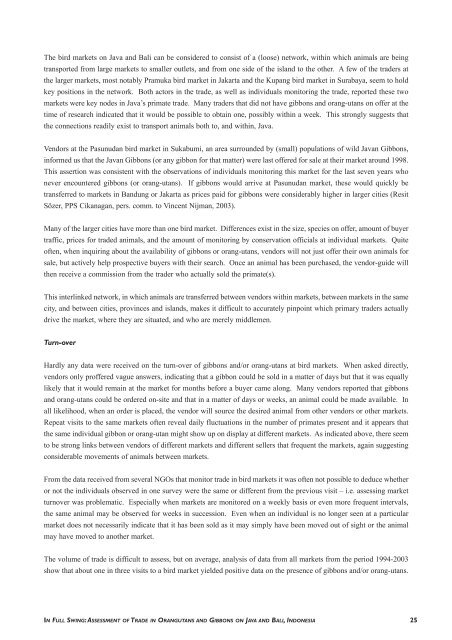
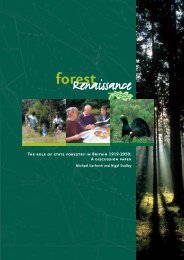
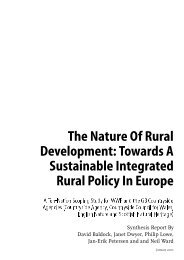
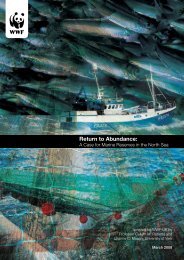

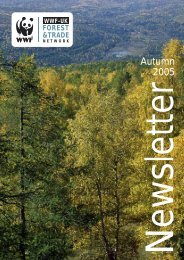


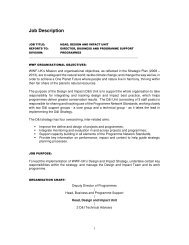
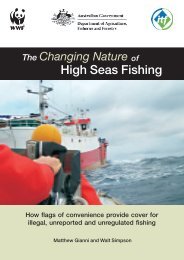
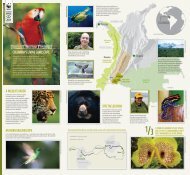
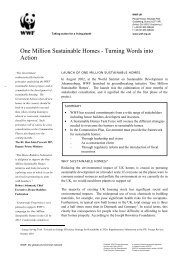
![[PDF] Causes for concern: chemicals and wildlife - WWF UK](https://img.yumpu.com/31929970/1/184x260/pdf-causes-for-concern-chemicals-and-wildlife-wwf-uk.jpg?quality=85)
